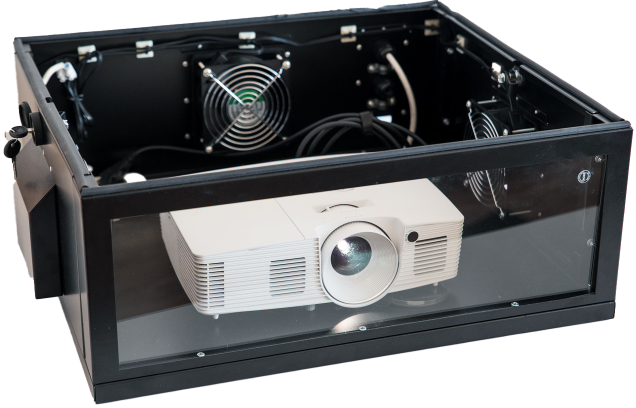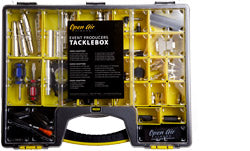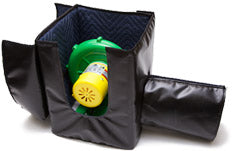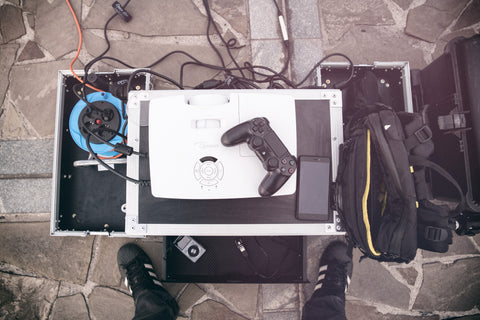Open Air Tutorial: Choosing and Operating an Outdoor Projector
Outdoor Projectors and Outdoor Projection
Welcome to Open Air Cinema's tutorial on outdoor projection. Outdoor projection conditions create a set of obstacles for your outdoor projector vs. a regular indoor projection environment. This tutorial brings together the collective wisdom and experience of our most talented outdoor projectionists and technicians to assist you in selecting the right outdoor projector and guide you through the process of using your projector for outdoor movie events.
This page discusses ambient lighting effecting contrast ratios, lumens, maintenance, and many more features related to outdoor projectors and outdoor projection.
Ambient Light/Contrast Ratios for Outdoor Projection
If a projector works well on a screen in a dark environment indoors, you cannot expect it will work as well on the same sized screen outdoors. You will need a brighter projector for outdoor projection!Here's why: imagine sitting in a dimly lit theater. You can see just enough so that you can get to your seat without tripping and spilling your over-sized drink. But you can barely see the advertisements projected onto the screen. This is because projection surface is actually bouncing the light in the room back into your eyes, making the movie screen, and the image on it, appear much lighter than when the lights have been dimmed.
Depending on the color temperature of the lights in the theater, the screen will reflects light-gray or an orangish pinkish color. Now look at the ads on the screen. Notice at that very moment the darkest portion of the projector's image never looks any darker than the light gray color of your projection surface. The blackest black you can see is actually that gray color. When the lights are turned off, and the screen is no longer reflecting ambient light, the projection image reveals deeper blacks.
Suddenly the projected image quality has vastly improved. The difference you see is referred to as an improved contrast ratio. Outdoor environments often include a number of variables that can negatively effect your outdoor projector's ability to project a high quality image. Moonlight, streetlights, headlights, houselights, campfire light, a late sunset, or even bright starlight can all affect your image.
Any kind of light will bounce off the projection surface back into your eyes, lightening the appearance of your outdoor movie screen. To pull off the perfect outdoor movie event, you will want your outdoor projection surface to appear black, not gray!
What's the Best Outdoor Projection Solution?
Turn off as many lights as possible. Angle your screen so that the projection surface is shielded from ambient lighting. After you have done your best to control the outdoor conditions, use a bright outdoor projector! The more lumens the better. We recommend:
- 9x5 ft screen - 2500 lumens minimum, 3000 lumens are ideal
- 12x7 ft screen - 3000 lumens minimum, 3500 lumens are ideal
- 16x9 ft screen - 3500 lumens minimum, 4000 lumens are ideal
- 20x11 ft screen - 4000 lumens minimum, 5500 lumens are ideal
- 25x14.5 ft screen - 5000 lumens minimum, 10000 lumens are ideal
- 40x22.5 ft screen - 5500 lumens minimum, 12000 lumens are ideal
How Many Lumens for Outdoor Projection?
If you have ever shopped around for a digital projector, you have most likely come across the term lumen more than once. In short, a lumen is a measurement of the intensity of light radiation projected by a light source.Back in the old days they called it candlepower, and measurements were taken in what were called candelas. One candela was the intensity of light radiating from a single candle made out of precisely 0.167 troy pounds of whale blubber of a consistency thick enough to burn at a specific rate for exactly eight hours. Easy enough, so long as you can manage to find whale blubber candles. Of course, it is no longer necessary to know the luminous intensity of whale blubber to pull off a successful outdoor movie event.
In these days of precise scientific calibrations, one candela can now be defined as the luminous intensity of monochromatic radiation emitted by a predefined source at a frequency of 540THz with a radiant intensity of 0.001464128 W/sr. Got it? Neither do we, and fortunately we don't need to know.
The American National Standards Institute (ANSI) takes care of all that for us and breaks it down into a measurement called lumens, which in simple terms is the measurement of the intensity of light emitted from a projector. Although it is not exactly correct to equate lumens with brightness we can generally say that an image projected through an outdoor projector with a high lumen count will be brighter than a projector with fewer lumens. The ideal is an outdoor projector bright enough to throw visuals that are sharp and easy to see in normal ambient lighting conditions - in other words, your audience can see your visuals without having to have the lights turned down to improve contrast. If you turn off too many lights, your audience may stumble around in the dark if they have to get up.
It's a good idea to keep some lights on and have a brighter outdoor projector to counter it. In order to make your outdoor cinema event deliver as much punch as possible, you will need to determine exactly what type of projector needed for your venue. If you have specific questions you can call us to discuss what you will need for your given screen size and venue conditions. We will be happy to assist you!
Weight of an Outdoor Projector
Projectors have come a long way. Only 10 years ago a 5000 lumen projector weighed nearly 90lbs, not including the case! The whole package required two to three people to move the outdoor projector around from venue to venue. Nowadays, projectors of the same brightness can weigh less than ten pounds.This is a huge benefit to all of us who do outdoor movie events. Now, one person can easily carry a projector bright enough to satisfy thousands of people. This is useful for outdoor cinema rental companies or events in many different locations. A lighter projector translates to more mobility and less headache.
Filters on Your Outdoor Projector
Your outdoor projector is an investment. To keep it running efficiently all manufacturers recommend regular air filter maintenance. The time between air filter cleanings/replacements can vary depending on your projector model and environment. If you use your projector often in dusty outdoor conditions - such as on a baseball diamond or near a backyard barbecue - the air filter can make the difference in your projector lasting a few months versus a few years. Clean filters insure good airflow. Your outdoor projector must constantly cool its housing and hot bulb. Nothing will diminish the life of your outdoor projector faster than operating on a clogged filter or blocked air intake.Changing or cleaning your filter is an easy process. With most models you can simply use your thumbnail to slide the filter out. Depending on how dirty it is, you can blow it off or wash it off. Make sure your filter is dry before replacing it. Never remove a filter from a projector that is on. It may be that your outdoor projection conditions will include large audiences that stir up dust.
For example, Open Air Cinema produced an event for 15,000 refugees in a UN camp in Tanzania along the Burundi border. The venue was nothing but dry red African dirt baked solid. As crowds of children gathered and danced to Tanzanian pop songs, clouds of dust rolled through the venue. We had anticipated these conditions and had an attached a secondary filter system to the side of our Sanyo projector.
With two thick filters in place, the dust never made it into the housing. The projector was safe, as it didn't clog with dust, and the event was a huge success! Keeping an eye on your filter helps insure that your projector stays healthy. Make sure to check it every time before you begin your outdoor movie event.
A few years ago we attended an outdoor movie screening at an open air amphitheater. The event producer had recently purchased an outdoor projector and was using it to screen outdoor movies throughout the summer. Halfway through the movie the projector shut itself down. Shocked and nervous, the projectionist managed to power it back on, but within minutes, it shut down again! By now the audience was counting in unison as numbers on the screen indicated cool down times and warm-up times. It became comical, and many were laughing and jeering the projectionist. But you can be sure that many others were annoyed. The projector was overheating and the projectionist didn't seem to be aware of it. Perhaps he had placed the projector too close to something, and it was obstructing the flow of air. Or maybe the filters were clogged. Our bet is it was the filters. It usually is!
Stay tuned for future tutorials: keystoning, proper cool down, familiarity with menus, LCD vs. DLP, FullHD vs. 4K, front vs. rear projection, projector positioning & placement, long throw & short throw lenses etc.







Hi!
I am looking for an outdoor theater set up. Ideally, I would like the screen (which I have sourced), to fit between two upright columns on our patio, which allows for a 132" (diagonal screen) 108"W. The projector would be approximately 36’ away on the other side of the yard/pool. Can you recommend the best projector for this application.
I am trying to project onto an 8′×14.5′ screen size from 40’ (it’s the long end of an existing pool)
Any possible recommends on a Projector?…and what is the best Lumens intensity it would need to provide?….thanks in advance…best…gordon
Brian, for your 12′ × 7′ screen to achieve 30’ – 35’ throw distance – projector with interchangeable lens is required. The most affordable current model from Optoma is EH503e. Lens that you’ll want is BX-DL300
’
Anna, unfortunately $250 is insufficient to purchase an outdoor movie projector in 2020. I’d recommend at least Optoma HD143X (1080p, 3000 lumens) retailing at $449
Very helpful article. I’m looking for some advice for an outdoor projector that could be placed 30-35 feet away from the screen, which will only be about 12×7. Can this be done, and if so, what specs will my projector need to support that?
Thanks!